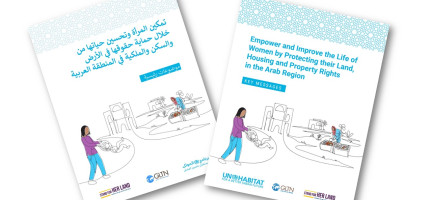Bahreïn
Page en construction.
Partagez avec l’Initiative Arabe sur le Foncier les documents, publications et autres informations qui peuvent être présentés ici. Écrivez à unhabitat-arablandinitiative@un.org
Legal and institutional framework
Bahrain’s legal system is based on civil law, customs and sharia (Islamic jurisprudence). The system primarily derives from the legal system of Egypt, which is based on the legal system of France. Bahrain’s legislative framework for urban planning was initially based on constitutional law, considered the general planning framework. However, constitutional law is supplemented by several other legislations that address specific aspects of urban planning. The most relevant legislative instruments include:
- Code of Expropriation for the General Interest No. 8/1970 and its amendments in 2005
- Code of Construction No. 13 of 1977
- Code of Real Estate Selling Contracts No. 16 of 1979
- Decree No. 28/1999 Respecting the Establishment and Organization of Industrial Estate
- Legislative Decree No. 3 of 1994 concerning the Division of Lands Intended for Construction and Development, as amended by Law No. 6 of 2005
- Legislative Decree No. 1 and 2 of 1994 concerning the Law of Urban Planning
- Civil Code (2001), primarily concerned with the Law of Obligations. It regulates rights to enter into agreements, the creation and dissolution of contracts, leases, mortgages and pledges
- Municipalities Law, promulgated by Legislative Decree No. 35 of 2001, as amended
- Legislative Decree No. 2 of 2001 on the Ownership by Non-Bahrainis of Built Properties and Land
- The Constitution (2002) establishes the social, economic, civil and political rights of citizens and the powers of the state
- Law No. 53 of 2006 designates Tubli Bay as a nature reserve
- Ministerial Resolution No. 95 of 2011 amending the executive regulations of Decree-Law No. 3 of 1994 regarding the division of lands intended for reconstruction and development issued by Resolution No. 56 of 2009
- Resolution No. 54 of 2012 regarding defining construction lines on main roads
- Property Registration Law promulgated by Law No. 13 of 2013
- Lease Law of 2014 on regulating landlord and tenant relationships and agreements
- Legislative Decree No. 25 of 2015 concerning Recovering the Costs of the Establishment and Development of Infrastructure in Urbanized Areas
- Resolution No. 4 of 2016 amends some provisions of the executive regulations of Decree No. 3 of 1994 regarding the division of lands intended for construction and development issued by Resolution No. 56 of 2009
- Resolution No. 196 of 2016 amended some provisions of the executive regulations of Decree No. 3 of 1994 regarding the division of lands intended for construction and development, issued by Resolution No. 56 of 2009
- Law No. 27 of 2017 promulgating the Real Estate Sector Regulation law
- Resolution No. 11 of 2017 regarding defining categories and a mechanism for collecting the cost of establishing and developing infrastructure in existing construction areas with facilities
- Decision No. 134 of 2018 regarding the controls and requirements for accrediting offices to review drawings, data, documents and maps necessary to issue building licences
The Code of expropriation for the general interest and its amendments No. 8/1970 and its amendments in 2005 aimed to regulate the appropriation of land by the Government or Municipalities for public purposes. Expropriation of land should be only for public purposes. The main reason for land expropriation in Bahrain is for national development projects. Legislative Decree No. 8 of 1970 authorized the government of Bahrain or a municipality in Bahrain to compulsorily acquire privately held land when it is in the public interest to do so. Acquisitions could only take place for a public purpose following this legislative decree. However, the Constitutional Court held this law to violate the constitution in case number D/2/2005, issued on 26 March 2007. The judgment, which nullified Legislative Decree No. 8 of 1970, came into force on 12 April 2007. Accordingly, it is currently no longer possible for the government to confiscate, condemn or compulsorily acquire land in Bahrain. It is now only possible with the landowner's consent [4].
Regulations specific to zoning and construction include:
- Decree No. 28 of 2009 on the determination of zoning regulations for construction in various areas of the Kingdom
- Decree No. 76 of 2018 on regulatory requirements that apply to housing projects
- Decree No. 55 of 2016 on amending some of the regulatory requirements for construction in various regions in the Kingdom issued by Resolution No. 28 for the year 2009
- Decree No. 15 of 2016 on the approval of classification maps for the Capital Governorate
- Decree No. 16 of 2017 on the approval of classification maps for the Northern Governorate
- Decree No. 17 of 2017 on the approval of classification maps for the Al-Mehraq Governorate
- Decree No. 18 of 2017 on the approval of classification maps for the Southern Governorate
Typically, land administration entities are created through legislative measures outlining their operational scope and necessary stakeholders. In Bahrain, the Survey and Land Registration Bureau was instituted under Land Registration Law No. 15, enacted in 1979 and subsequently revised by Law No. 13 in 2013. According to this law, the Survey and Land Registration Bureau “shall undertake surveying, registration and land valuation for lands in the Kingdom of Bahrain, following the provisions of this law, by-law and the resolutions issued in implementation thereof. It is the primary reference for all lands in Bahrain, including the maintenance and updating of the land information database” (2013). The law outlines the primary responsibilities of the bureau, which encompass surveying, registration and valuation, and designates departments to oversee these tasks.
Bahrain’s land administration system began in 1924 when the state was established. Over time, it has undergone various phases of organizational development, adapting to different historical periods. At present, these are the primary organizations that oversee land administration:
• The Survey and Land Registration Bureau is responsible for all surveys (including cadastral, topographic and hydrographic) as well as land registration, which covers land titles, land certificates, ownership information, land value, topographic maps and hydrographic charts. These are the main products and services provided by the Bureau. Cadastral and topographic maps full cover Bahrain’s land mass. Lands in the country are registered as either state land (government) or private ownership. The Bureau maintains a land registry where each property, description and legal status is entered. Facts and information recorded in the land registry are considered final and conclusive proof of the matters they describe and information recorded in the registry is considered proof of ownership. Details in the register cannot be altered except by court order or upon receipt of a notarized declaration from a party approved by the Minister of Justice and Islamic Affairs. The Bureau Director may correct material errors in the land register according to the appropriate legal instruments of ownership or disposal. Registered land cannot be acquired through adverse possession or prescription. The rights of others that encumber the land must be written on the title to that land, and failure to follow such registration renders the rights invalid. The King of Bahrain guarantees titles to lands registered in the registry, which cannot be annulled or overturned.
The Ministry of Works, Municipalities Affairs and Urban Planning is responsible for all planning, zoning and building activities. The Ministry’s primary role is development of zoning plans, master plans and development permits; it also launched the National Planning Development Strategy in 2007, Bahrain’s land-use policy. The Real Estate Regulatory Authority is designed to deliver a transparent and sustainable regulatory environment for the real estate sector, promote investment and protect the rights of consumers. The Bahrain Chamber for Dispute Resolution was established by Bahrain Legislative Decree No. 30 of 2009.
Decree No. 47 and No. 48 of 2017, amending Decree No. 54 of 2007, established the Urban Planning and Development Authority. Decree No. 68 of 2012 reorganized the Ministry of Works, Municipalities Affairs and Urban Planning, which is responsible for land subdivision, merging, rezoning study, hydro-dynamic studies assessment, special nature projects review, traffic studies approval and land adjustment.
Land tenure
Most land is registered as state land or private ownership. The Survey and Land Registration Bureau maintains a land registry wherein each property, description and legal status is recorded, and considered final and conclusive proof of the matters described in the land registry. Details in the land registry cannot be altered except by court order or upon receipt of a notarized declaration from a party approved by the Minister of Justice and Islamic Affairs. The bureau director may correct material errors in the land registry according to the appropriate legal instruments of ownership or disposal. Land registered in the land registry cannot be acquired through adverse possession or prescription. The rights of others that encumber the land must be registered on the title to the land. Failure to do such registration shall render such rights invalid, whether the parties concerned or third parties. Title to land registered in the land register kept by the bureau is guaranteed by the King of Bahrain.
Landowners in Bahrain usually register their land, and transferring property or use from one party to another is considered reasonably easy. However, the existing regulations and circulars regarding the registration of cadastral surveyed plots and the laws on acquisition and ownership are minimal. Both Bahrainis and non-Bahrainis can own land in the country, as regulated by Legislative Decree No.2 of 2001. The processing time for property registration varies according to the parcel’s status, from 14 days in typical cases to 360 days for complicated ones, such as if the land is in a non-planned area.
The housing sector is one of Bahrain's most important economic sectors. The Government has strongly supported the provision of housing throughout past decades, mainly through the financing of private housing construction. However, urban land is very expensive, and purchasing urban properties is unaffordable for many. Land in rural areas for agricultural use is more affordable. Obtaining funds (loans) to purchase lans or property is easy for most citizens, making land tenure security overall good for Bahrain nationals.
Land value
The Survey and Land Registration Bureau is the agency responsible for land valuation in Bahrain. While there is a methodology for land value evaluation, it is not published and does not cover all types of lands. There are few real estate valuers available in Bahrain, and their services are costly. One of the main issues in determining and understanding land value in the country is the lack of a complete and accessible (digital) land information system that keeps track of land values. Land speculation hinders effective land use planning by the government.
Real estate in Bahrain is subject to transfer taxes. When a property is purchased, the buyer must pay 2% of the transaction value to the tax authorities. If the transfer tax is paid within two months of completing the purchase, the rate decreases to 1.7%. Property owners in Bahrain are also required to pay annual municipal taxes, which amount to 10% of the estimated rental value of the property [5].
Land use
Land uses in Bahrain fall into different categories, including residential areas (12.11 per cent), special nature projects areas (33.43 per cent), public services and utilities areas (11.67 per cent) and protected areas (23.31 per cent) [6]. The Ministry of Municipal and Rural Affairs leads the setup of a spatial planning system consisting of the National Spatial Strategy and local plans at the neighbourhood level. The Ministry of Works, Municipalities Affairs, and Urban Planning and the Urban Planning and Development Authority (UPDA) are the responsible agencies for land use.
Most farmlands in Bahrain experience some form of desertification. Salinity presents in cultivated lands due to groundwater depletion and seawater intrusion. The high demand for housing and recreational facilities has taken a toll on arable and rangelands. Most valuable agricultural lands and wild lands have been converted to residential areas, amid soaring land prices and demand, leading to the existence of virtually no rural areas in Bahrain. Land scarcity, high population density and demand for housing and commercial compounds has forced authorities to review building codes and allow high-rise buildings [7].
Building permit regulations and other existing standards controlling suburban developments are not yet effective enough to control and manage land subdivisions in suburban areas and non-urban localities around larger cities in the Kingdom. These challenges in urban and suburban areas result in the number of land grants and affordable housing projects implemented by municipalities in remote areas where free government land is available. This usually means that such areas are subdivided and allocated allotments without infrastructure. This represents a significant urban management and investment problem for the future. Moreover, the social tradition of relying on land as a form of investment leads to demand for residential allotments is considered to hamper progress with land management, which far outstrips the requirement for actual housing allotments [8].
Bahrain is actively pursuing economic diversification and sustainable management of its natural resources. As an island nation, it faces significant challenges from climate change, particularly rising sea levels. To address these concerns, the Kingdom has implemented various initiatives under its national framework for sustainable development. These efforts encompass a range of socioeconomic strategies such as the National Economic Strategy, the Economic Vision 2030 for Bahrain, Bahrain 2030 National Planning Development Strategies and Bahrain’s Future Skills Strategy.
The cabinet officially approved the National Environmental Strategy through Edict No. 02-1902, released in 2006. It contains foresight and action points for several environmental issues, including air pollution and climate change, water conservation and pollution control, land resources and marine and coastal environment. Other sections deal with mainstreaming environmental concerns into sustainable development. Special attention is given to tourism, transport and waste management.
The Kingdom’s other environmental initiatives include the National Biodiversity Strategy and Action Plan, the National Desertification Plan and Strategy and Bahrain 2030 National Land Use Strategy. Some of these strategies are still in draft form while others are in their final stages. Progress has been made in implementing the Barbados Programme of Action, however the lack of financial resources and inadequate technical and technological capacities hinder achievements.
Land development
The 2007 National Structural Strategic Plan presents a long-term vision for Bahrain over the 2030 horizon. The plan reflects the desire of relevant authorities to balance economic, social and environmental sustainability to achieve sustainable development [7]. The Ministry of Works, Municipalities Affairs, and Urban Planning and the Urban Planning and Development Authority (UPDA) are the responsible agencies for land development in Bahrain.
Bahrain’s socio-economic development has been marked by increased demand for land for urban development and declining areas under agricultural areas. Accelerated population growth coupled with social development and economic growth has increased demand for land to cater to housing and development needs. This has pushed local authorities to resort to the reclamation of shallow-water coastal zones and the transformation of agricultural areas into urban and commercial areas. Dredging and reclamation operations have expanded Bahrain’s coastal zones to accommodate new residential and commercial areas, artificial leisure islands, seaports and bridges and power generation and water desalination plants. As a result, Bahrain’s size grew at an average increase of 1.4 to 1.5 km2 per year between 1936 and 2009. However, expansion of land mass into the sea may be impacted by rising sea levels, which risk submerging between 27 and 56 per cent of Bahrain [9].
All major projects are concentrated in the northern part of the country as the southern part is largely private or reserved for mining and oil. Land acquisition for government land grants and public housing has become tricky as landowners are reluctant to release their land for public investment. It also suffers from the lack of defined policies concerning the use of state land or standards for its management. Concerning land expropriation, additional oversight can ensure that people’s rights are respected in the process. Linkages to the judicial system are critical for compliance with applicable rules, including adequate notice, fair and prompt compensation, and alternative resettlement.
One strength of the Bahraini land sector is the existence of efficient regulations to control land subdivisions, mechanisms ensuring construction is aligned with land-use regulations, and effective tools to change.
Land dispute resolution
The Bahrain Chamber for Dispute Resolution and the supreme judicial council are the responsible agencies for land dispute resolution in Bahrain. A well-structured formal system exists to resolve conflicts and disputes related to land rights and parcel boundaries. The juridical system is affordable for the poor and other vulnerable groups. However, it is not very familiar to citizens.
The number of land dispute cases in the Courts in Bahrain is unknown. Typical disputes include allegations of land grabbing, competing for claims over ownership, double allotment of plots to individuals during the formalization process, land acquisitions for urban expansion and various disputes involving minority groups. Appeals are not always handled promptly, judges can adjudicate appeals based on the lower court’s findings, disregard previous rulings, and apply their own interpretations of Sharia, which may lead to divergent conclusions even in apparently identical cases, making predicting legal interpretation difficult. Enforcement of court decisions can present obstacles, particularly when powerful actors are involved and some concerts exist on the extent to which women's and children’s property rights are protected.
Key documents and links
[1] Kingdom of Bahrain Supreme Council for Environment (2023). Natural Reserves: Environment in Bahrain.
[2] Kingdom of Bahrain Supreme Council for Environment (2020). Bahrain’s Third National Communication under the United Nations Framework Convention on Climate Change.
[3] UN-Habitat/GLTN (2024). Bahrain Land Sector Assessment: Background Paper.
[4] Zowayed, K. and Watkins, K. (2024). Global Corporate Real Estate Guide: Bahrain. Baker McKenzie.
[5] Clear Finances (2023). Taxes in Bahrain [2023] – A Complete Guide.
[6] Bahrain Urban Planning and Development Authority (2024). Land Use Statistics.
[7] The Public Commission for Protection of Marine Resources, the Environment and Wildlife (2009). Bahrain National Assessment Report on Implementation of the Mauritius Strategy (MSI) of the Barbados Programme of Action (BPOA). The Public Commission for Protection of Marine Resources, the Environment and Wildlife.
[8] Bahrain Urban Planning and Development Authority (2021). Subdivision Regulations Simulator. The Urban Planning and Development Authority.
[9] Bodetti, A. (2019).Will Bahrain Disappear Beneath the Waves?. Lobe Log.
Clause de non-responsabilité
Les informations contenues dans cette page sont basées sur l'ensemble des connaissances développées par ONU-Habitat, GLTN et les partenaires de l’Initiative Arabe sur le Foncier. Les désignations utilisées et la présentation du matériel n'impliquent l'expression d'aucune opinion de la part du Secrétariat des Nations Unies concernant le statut juridique de tout pays, territoire, ville ou zone, ou de ses autorités, ou concernant la délimitation. de ses frontières ou limites, ou concernant son système économique ou son degré de développement. Les informations peuvent contenir des inexactitudes en raison de la ou des sources de données et ne reflètent pas nécessairement les points de vue d'ONU-Habitat ou de ses organes directeurs.
La page du Bahreïn est encore en construction. Partagez avec nous toute information, ressource ou correction pertinente pour enrichir notre bibliothèque. Contactez l’Initiative Arabe sur le Foncier à unhabitat-arablandinitiative@un.org !





